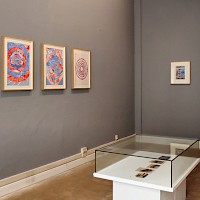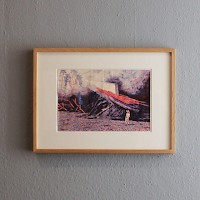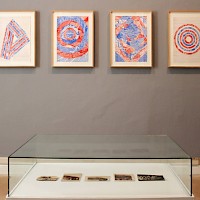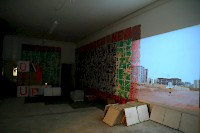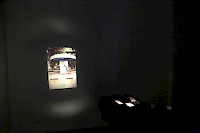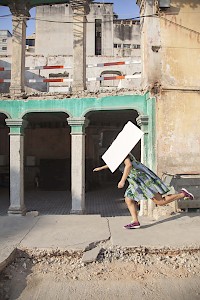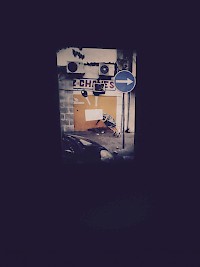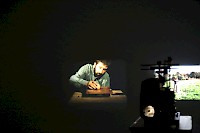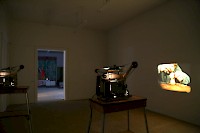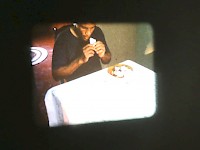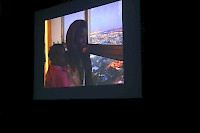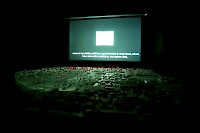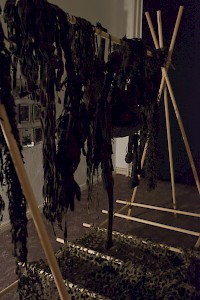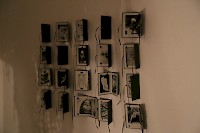Exhibition
DEVOUR! part I, Berlin
Social Cannibalism Political Redefinition Architecture
March – April 2015
Freies Museum, Berlin
in Cooperation with SAVVY Contemporary
Artists: Jordi Colomer, Matias Machado, Pedro Paiva und Joao Maria Gusmao, Edouard Baribeaud, Pedro Valdez Cardoso, AfrikPlay (Jord den Hollander, Lotte Stoops, Catarina Alves Costa, Ingrid Martens), E-Studio Luanda
Curator: Marta Jecu
Being a research project, based on long term preoccupations with social-architectural phenomena, DEVOUR! blends the work of artists with architects, collectives and curators to follow the emergence of architectural or urbanistic hybrid situations, as a consequence of processes of what could be called cultural and social anthropophagy. The project touches on various contexts in which hybrid structures and practices emerge - legacy of processes of social cannibalism: devoration, imposed absorbtion of cultural paradigma, unassimilated consumption. Their monstrous, sacrificial, suicidal, but also innovatory outcomes focused on architecture and living practices, permeate this project.
A hybrid is exposing by its very nature the interaction of its incongruous sources. It is the outcome of a missed assimilation, an unsuccessful crossbreeding that nevertheless powered a new entity, which carries a strong political relevance and fuels a new configuration.
The exhibition at Freies Museum delves into such paradigmatic cases in which present mutated and dysfunctional structures (buildings, environments, living situations and imaginary environments) are revealed to be late consequence of lingering Eurocentric spatialisation and its often abusive consequences. At the same time, theese cases carry the regenerative power that shifts thinking patterns and converts to new historical paradigms. Historic and archival material will be blended with contemporary artistic work.
The entire project and this exhibition circle around the Brazilian early modernist notion of anthropophagy and its emancipatory potential, which accompanied the emergence of postcolonial regenerative thinking and triggered a material shape to an utopic architecture that was to create a new social identity.
In his Anthropophagic Manifesto of 1928, in Sao Paulo, Oswald de Andrade touches - with a mix of suprarealism, lucid criticality and malice - on fundamental sore points present in the epoch: “I asked a man what Law was. He answered it was the assurance of the exercise of possibility. That man was called Galli Matias. I ate him.” According to critics from the epoch, Galli Matias alludes with a play of words, to an Eurocentric confused and self-propagating discourse. De Andrade also declares to be “Against all importers of canned consciousness', meaning induced socio-ethnological studies, imposed on the reality of the Brazilian cultures. "Tupi, or not Tupi that is the question," de Andrade also famously asked (in English) in his Manifesto. Cannibalism (and the figure of the indigenous Brazilian cannibal) was adopted as a metaphor for a new Brazilian identity that would devour and assimiliate European culture and the European impositions of models, along with the image of one's own cultural inheritance, to produce a native national art free of its colonial past.
In this way modernism became the formula for this postcolonial identity. On the other hand this architecture was also meant to create concrete, practical solutions for local living: inclusive environments and functional solutions for the necessities of a modern Brasilian.
Included in this exhibition, documentary material (images and texts) connect the Anthropophagic Manifesto of Oswald de Andrade with a few sources on Flavio de Carvalho – a Brazilian little known personality who fused in the 1950' architecture, urbanism and performance into social utopia.
Flávio de Carvalho (1899 – 1973) is best known for his Experiências. They are all staging situations that would determine a mutation of social rituals. Experiência no. 3, which is documented in this image collection, shows de Carvalho wearing his own designed futuristic new costume for men: a sort of functional architecture-dress that would provoke a freer and more climateric adequat movement in space. Besides his Experiências, de Carvalho was a prolific writer, architect, journalist and dramaturg. Architecture as a cultural structure that acts ‘upon the body’ is de Carvalho's vision, according to Inti Guerrero [1]. Maybe for the first time, performance (in a modern way) is blended here with urbanism, for a subjective experience of architecture. De Carvalho envisioned an utopian urban master plan, 'A cidade do homem nu' ('The City of the Naked Man'), imagined as a metropolis for the man of the future. In here the human should be without god, without property and without marriage, a 'naked mankind' stripped from its cultural constructs - or as Carvalho out it, from 'scholastic taboos' [2]
This collection of images presents also some of the remains of his realized architectures in Sao Paulo: Fazenda Capuava and the house complex of Alameda Lorena.
Associated to it, a projected video work of Jordi Colomer ('Anarchitekton Brazil', 2002-2004) – performs a de-fossilisation of this paradigmatic Brazilian architecture. A man carries the modernist buildings on his sholders and crosses the city running, temporary embodying their political identity.
The Brazilian modernism had important repercussions on the last decades of the colonial rule in African countries. Modernism in Africa was both an architecture of domination (via implanted European models) and a measure to fight against colonialist imposed habitation (via Brazilian modernist solutions with which (mostly) local architects tryed to adapt the European modernism to African necessieties. With Brazilian modenism, Portuguese speaking African countries were fighting the fascist architectural models of Antonio de Salazar imposed from Portugal. In the '50 and '60s (for example in Mozambique and Angola), local architects corroborated these European patterns with imported modernist building solutions from Brazil (of some decades earlier), addressing for the first time African local climateric conditions and necessities with plans defying hierarchical and exclusive use of space. These contributed to the formation of the so-called 'late modernity' in Africa, an empacipatory movement.
A collection of 4 documentaries will follow up some concrete late colonial buildings in their present state – hybrid environments which expose the megalomania and dysfunctionality of the late colonial projects, reflected back through their present consequences, on a both social and individual level. Each film presents a case study on architectures from Tanzania, Mosambique, Capo Verde and Johannesburg. These cases reveal at the same time also the regenerative agency of small-scale initiatives of their present inhabitants, which offer creative solutions from within. It becomes obvious in these cases how the contemporary architecture understood as spatial practice, constantly renews itself through topical initiatives, fighting against an architecture of domination.
The documentaries on the Grande Hotel Beira in Mosambique, the Ponte Building in Johannesbiurg, the vernacular housing colony of Santiago in Capo Verde and the first generation modernist architecture in Tanzania are part of the Lisbon film archive AfrikPlay (afrikplay.wordpress.com).
The works of Pedro Valdez Cardoso and Edouard Baribeaud, dive a century back into the second half of the 19th century when practices of travel meant (temporary) occupation linked to colonial exploration. Pedro Valdez Cardoso traces (in installation and abundant archival material) colonial encampment structures in Central Africa. These provisional architectural markers of territorial authority combine European military apparatus with local building techniques – a hybrid form that reflects superposed alphabets of power, reminiscences of traumatic and provisional living conditions, decayed relations and subjugation of the other's reality.
The collection of drawings of Edouard Baribeaud is combined with archival photography made by explorers in Brazil with their early photographic techniques (mostly from the Albert Richard Dietze (1838-1906) Collection and kindly borrowed by the Ibero American Institute, Berlin). Baribeaud's drawings are constructed on a dualistic principle, both on a formal level and regarding his motives (confrontation versus peace, sensorial vs. rational impulses, utopia and the imaginary vs. documentation). His drawings nevertheless are distancing themselves from these much contested binary principles (especially when these are associated with geographical separations and presumed cultural poles). He breaks and abstractizes this historic Eurocentric imaginary and together with it, its political charge, by introducing empty zones, what he calls 'projection screens'. This association of his work with explorer's photography follows also how the political agency of the medium of representation itself is reinforcing an anthropophagic context: the technical determinations of drawing or the first models of a camera – produce a crossbreed projective-fictional-documentary gaze on the encountered subject.
The Portuguese duo Pedro Paiva and Joao Maria Gusmao also work with the limits of observation and an inherently distorted assimilation of the reality of the Portuguese colonialism. The necessity of a hallucinatory dimension is seen as a possible catalyst for change, which is linking the individual back to a supposed immemorial (and for the European civilisation unaccessible) time. 'Columbus Column' and 'How to Swerve the Earth Axis' remind of iconic images of the Brazilian modernism, the link between de-colonising thoughts and utopian architecture and the delusive search for the center of the world. 'Hydraulics of Solids' (Man Eating Stones) is pointing to an impossible assimilation, or an intellectual absorbtion, complementing an orgiastic ingestion in 'Man Eating Papaya'.
e.Studio Luanda (http://www.e-studioluanda.com/) presents u.topia Luanda Machine, which is a kit of traveling boxes in which items of material culture are collected from the various stations in which the machine has 'worked'. Out if it, Francisco Vidal makes live paper and drawing performance. On the u.topia boxes a projection of diapositives record the performance of Rita GT in Luanda. These blind spots or censured moments are performed by her in paradigmatic places sites in the city of Luanda, in which the recent history of the city is visible: modernist architectural details from the colonial time in their present state of decay or transformation. e.Studio Luanda have worked in the past years in Luanda – a city which itself is a new hybrid functional model, destabilising any postcolonial polarisation. While Portuguese, Chinese, Eastern Europeans and Angolans alike in search for employment supra-populate Luanda, one of the most expensive capitals of the world, formal and informal economic practices are fusing into new urbanistic configurations.
Matias Machado reconstructs in real proportions a habitation quarter in Cordoba, Argentina, and records the changes that it went through in the past years, due to private and corrupt interests exercised there by multinational corporations. Monsanto had a forced extension in Cordoba and employed the population in abusive conditions, which was followed by an enormous amount of victims. Their homes are marked by Matias Machado on the model and two interviews with local activists discuss the consequence of these geopolitical interests. A constantly changing city plan (due to extension of Monsanto, that the population is forced to accept) reflects a continuous process of marginalisation, dissolvation and loss.
1. If I Can't Dance and Inti Guerrero in Conversation, Flávio de Carvalho – Inti Guerrero, http://www.ificantdance.org/Editions/EditionIV/FdeCarvalho/03-Texts?popups=/Editions/EditionIV/IntiGuerreroinConversation
2. Flávio de Carvalho by Inti Guerrero in Afterall Magazine, Nr. 24, Summer 2010
